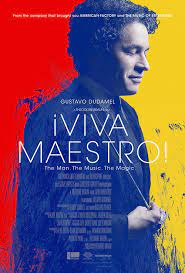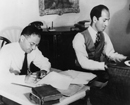Reviews
¡Viva Maestro!: Two Reviews and a Correction


Theodore Braun’s new film ¡Viva Maestro! documents the conductor Gustavo Dudamel as he prepares Venezuela’s Simón Bolívar Symphony Orchestra for a 2017 international tour through to 2018, when he conducts performances in Chile in honor of his mentor, the late music educator and activist (and founder of El Sistema) José Antonio Abreu. Two reviewers of Braun’s work found much to admire in both Dudamel and the documentary, but drew somewhat different conclusions about the film.
The L.A. Times classical music critic Mark Swed, who has observed Dudamel up close since the young Venezuelan first led the L. A. Philharmonic in 2005, characterizes ¡Viva Maestro! as a “compelling new documentary” that has at its heart “Dudamel’s personal character and the character of his music making.” Unlike many maestros, Swed argues, the two are the same in Dudamel’s case. “What you see is what you hear,” he writes, “and that’s what makes him and the movie riveting.”
In The Washington Post, Thomas Floyd, an editor and writer (but not a music critic), finds the film “a compelling but incomplete look at the prodigious Venezuelan conductor” while also recognizing what he identifies as “the immeasurable ‘it’ factor that [has] made Dudamel such a wunderkind.” Floyd and Swed both single out a few moments captured in the film when, during rehearsal, Dudamel focuses his orchestra on the first four notes of Beethoven’s Fifth Symphony with, in Floyd’s words, “precision and aplomb.”
Swed goes deeper, suggesting that “for Dudamel, those four notes must represent defiance. He provokes the orchestra to evoke the spirit of fight and channel everything life-giving in Beethoven.” The result of such attention to detail, Swed notes, are “jubilant audiences in Hamburg’s spectacular Elbphilharmonie [that] give a rare-for-Germany standing ovation. The great joy of ¡Viva Maestro!,” he continues, “is how well Braun captures the sensation of Dudamel conducting and the sound of the orchestra.”
He can't go home again
The film takes a more serious turn when the Simón Bolívar Symphony Orchestra returns home to Venezuela, which is increasingly wracked by violent protests against the Maduro regime. Whereas the earlier scenes of the tour preparation in Caracas largely avoided the poverty and despair that underlay it, events on the ground make it impossible to ignore it any longer.
Braun, writes Swed, “gets behind the scenes enough to show Dudamel watching the riots in Caracas on his phone in his Walt Disney Concert Hall office.” The conductor finally speaks out with condemnations of the violence and calls for free elections, actions that make it impossible for him to return to his home nation.
Floyd is less convinced by Braun’s treatment of the events in Venezuela. “[He] tries to hit the necessary notes as his film takes an unexpectedly timely turn, but their delivery is flat,” he writes. “Dudamel himself has little to add beyond recitations of the views he has already shared on Facebook and in a New York Times op-ed.” The dissolution of the orchestra “gets frustratingly little follow-up. And the death of a teenage violist during a demonstration in Caracas is mentioned in puzzlingly brief fashion.”
Swed agrees that Dudamel’s “explanations in the film that music is the only thing he has to make a difference” are inadequate. But, he continues, “the complexities of the situation in Venezuela are beyond the scope of this film.” In the end, the film’s viewers will learn of Dudamel’s “exceptional ability to compartmentalize.”
Swed wishes that the film included more scenes of the conductor at work: “[The] hours and hours of rehearsal and performance outtakes, as well as commentary track with the conductor and director, is the document we need.” Floyd agrees that the music is at the center of things. “¡Viva Maestro! fares better,” he notes, “in service of what one can only assume was its original intent: shining a light on Dudamel’s generational genius and his advocacy for music as an ‘essential human right,’ especially among Venezuela’s youth.”





 FEATURED JOBS
FEATURED JOBS

 RENT A PHOTO
RENT A PHOTO


